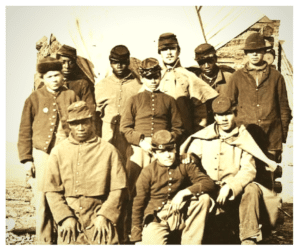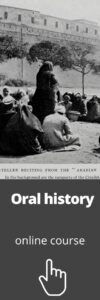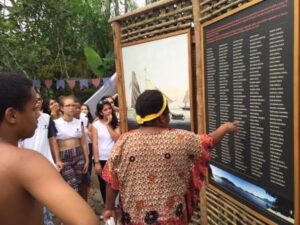Oral History Sources are narratives, statements and testimonies transmitted orally, usually by people who lived through or witnessed certain historical events.
But how do you develop a project to collect these testimonies and how do you make them available?
In this article we will systematize the guidelines for a project based on Oral History Sources.
This topic is developed in detail in the online course with certificate Oral History
You can read this post in Português | Español
What are Oral History Sources?
As mentioned above, oral history sources are accounts and testimonies transmitted verbally, usually by people who lived through certain historical events.

These historical sources are important for history, especially in contexts where written records are scarce or non-existent.
The historian collects these testimonies through interviews, recordings or even by collecting oral traditions passed down from generation to generation.
Oral History
Oral history makes it possible to preserve personal and collective memories, often offering a complementary perspective to history based on official written records.
These oral history sources can include:
- Interviews with people who lived through certain historical events;
- Narratives from communities that preserve cultural traditions or memories;
- Testimonies from marginalized people whose voices may not be recorded in traditional written sources;
- Oral traditions such as tales, myths and legends.
They are widely used by historians and anthropologists to build a more complete and diverse view of the past.
The oral history project
As in any other field, a project based on oral history sources starts with an idea.
And it must follow a rigorous methodology.
Here are some guidelines that everyone can follow when preparing an oral history project.
Choosing a project based on oral history sources
To organize ideas, before starting to work with oral history sources, we can ask ourselves:
- What are the intended objective(s) of this project?
- How does my project contribute to the understanding, management and conservation of cultural heritage (within an institution or otherwise)?
- How does my project contribute to the general public’s perception and knowledge of cultural heritage?
- What preparatory research should I carry out? Where can I look?
- Who will I interview? Why? How? Where? Where?
- Will the interviewees I propose to involve in my project benefit? At what level?
- Is the project well supported in terms of finance, human resources, equipment and time?
- How will I carry out the promotion?
- What will I do with the materials collected (recordings, videos and associated documentation) once I have finished?
- How will I archive it, where and under what authority?
This series of questions can be used at the start of the project, as well as throughout its various phases, to ensure that we are staying on track.
What’s more, we can apply them to different types of work in the field of oral history, from school work to collecting information for archives for professionals in the field of historical research.
a short overview of the stages of a project based on oral history sources
Research and mapping of the field of action

After defining what he wants to work on, the historian will have to find out more about the subject. He will do this by researching oral history sources.
Preliminary research is fundamental to the project.
Based on the information you have gathered, you will have to map out your field of action.
Basically, this means that you will define the site(s) of relevance to your oral history study. After all, people’s memories are related to the places they’ve been, where they’ve lived, where they’ve passed through.
Who to interview and how to approach the public in an oral history project

Quilombola griô (or griotte) Marilda de Souza telling students about the history of the Quilombola community and the slavery of the slave farms on the coast of imperial Brazil. Presentation of the Past Present project (November 2015), at Quilombo do Bracuí (Rio de Janeiro, Brazil).
If the individuals’ contact details have been duly noted and filed in the first phase, all that’s left to do is to try to establish the first contact and find out to what extent they would be interested in contributing to the project under development.
Where to go
The location or surrounding landscape can be of great importance when collecting oral history sources, because of the memories associated with them. Someone who has known a particular site, building or landscape first-hand can make a valuable contribution to identifying and characterizing a function, occupation or relationship that may exist, through the stories they tell us.
Organizing prior information and supporting documentation
Essentially, the information prior to the interview process consists of a clear and concise summary that will allow future understanding of the documents to be created during the next phase.
The interviewer/historian’s notes will help the transcriber or other fellow historians and researchers (or other future users) to better understand the interview, the interviewee and the contexts.
